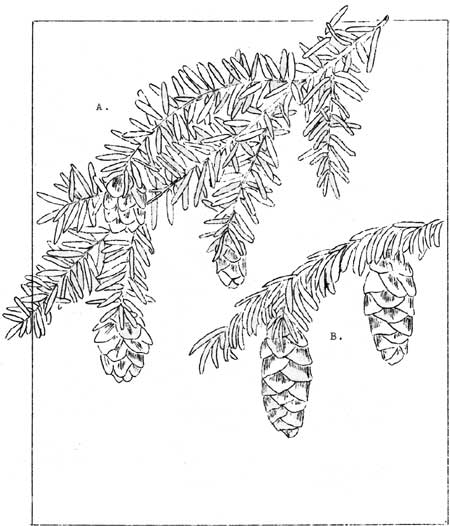WESTERN HEMLOCK.
(Tsuga heterophylla)
This is the most common tree in Mount Rainier National Park,
occurring from the lower park boundaries to an upper altitudinal limit
of 5000 feet. It is particularly abundant in the dense forests of the
lower elevations where its principal associates are the Douglas fir and
western red cedar. Being a prolific seed producer and very tolerant of
shade, it thrives in these dense forests and often forms nearly pure
stands over considerable areas. Its seedlings are very numerous. Seeds
readily take root in decaying logs or stumps and one may often find
colonies of seedlings growing high above the earth, rooted in a fallen
log that bridges a deep ravine.
The western hemlock grows to a large size here, mature
specimens being from 100-200 feet tall and from 2-5 feet in
diameter. On mature trunks the bark is deeply furrowed and
ridged, scaly and, on the exterior, a dark reddish-brown to almost black
in color. The inner bark, which can be easily exposed to view by
scuffing the outer bark away, is a deep maroon-red. Young trees have
thin, scaly grey-brown to red dish-brown bark. The dark, glossy-green
foliage is characterized by numerous needles of irregular length
which lends a "lacy" appearance to the tree. Individual needles are
flat, from 1/4-1 inch long, soft to the touch, blunt at the tip and
narrowed at the base into slender, short petioles. Another feature which
aids in the identification of this tree is the manner in which the weak
central leader droops under its own weight. This is particularly evident
on young trees. The cones, which mature in one season, are produced in
large numbers, are 3/4-1 inch long and are borne at the tips of the
branchlets. The western hemlock is a rather long-lived tree and many of
the larger specimens are undoubtedly from 300 to 500 years of age. The
wood is fine grained, yellowish brown in color and outside of the
national park, it is widely cut and utilized for a variety of
purposes.
The western hemlock will be found along the Pacific Coast from Alaska
to northern California and, inland, in British Columbia, northern Idaho
and western Montana. It reaches its greatest size, however, in the coast
region of British Columbia, Washington and Oregon.
-oOo-

WESTERN HEMLOCK (Tsuga heterophylla). A-Twig, illustrating
cones and foliage (x1).
MOUNTAIN HEMLOCK (Tsuga
mertensiana). B-Twig, illustrating cones and foliage (x1).
-oOo-
Descriptions continued...

